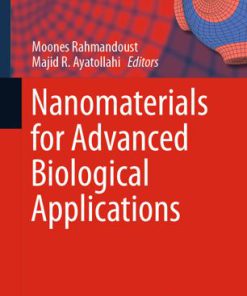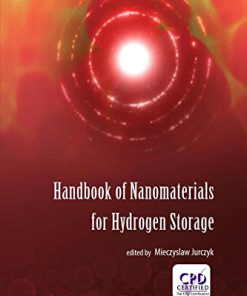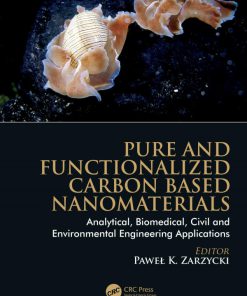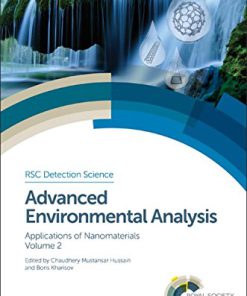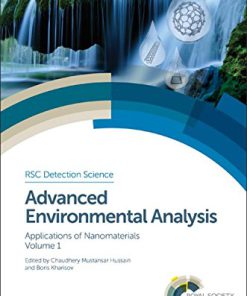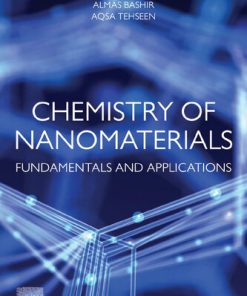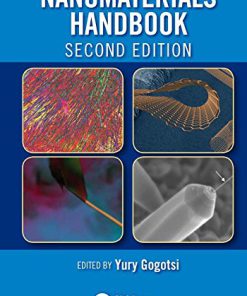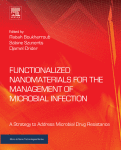Handbook of Functionalized Nanomaterials for Industrial Applications 1st Edition by Chaudhery Mustansar Hussain 0128167885 9780128167885
$50.00 Original price was: $50.00.$25.00Current price is: $25.00.
Handbook of Functionalized Nanomaterials for Industrial Applications 1st Edition by Chaudhery Mustansar Hussain – Ebook PDF Instant Download/DeliveryISBN: 0128167885, 9780128167885
Full download Handbook of Functionalized Nanomaterials for Industrial Applications 1st Edition after payment.
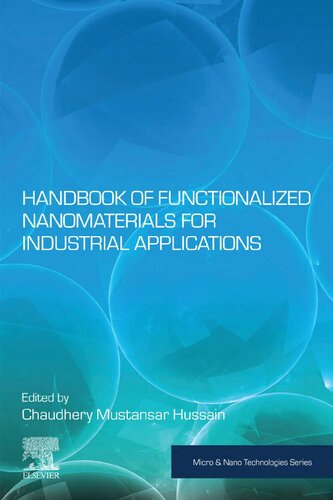
Product details:
ISBN-10 : 0128167885
ISBN-13 : 9780128167885
Author: Chaudhery Mustansar Hussain
Functionalized nanomaterials have extremely useful properties, which can outperform their conventional counterparts because of their superior chemical, physical, and mechanical properties and exceptional formability. They are being used for the development and innovation in a range of industrial sectors. However, the use of functionalized nanomaterials is still in its infancy in many industrial settings. Functionalized nanomaterials have the potential to create cheaper and more effective consumer products and industrial processes. However, they also could have adverse effects on the environment, human health, and safety, and their sustainability is questionable, if used incorrectly. This book discusses the opportunities and challenges of using functionalized nanomaterials in a variety of major industrial sectors.
Handbook of Functionalized Nanomaterials for Industrial Applications 1st Table of contents:
1 Different kinds of functionalized nanomaterial for industrial use nanomaterials
1.1 Introduction
1.2 Nanotrends in industrial development
1.3 Potential of nanomaterials
1.4 What are functionalized nanomaterials?
1.5 The use of functionalized nanomaterials in industry
1.5.1 Food
1.5.2 Energy and environmental sectors
1.5.3 Other applications of engineered nanomaterials
1.6 Current research on nanomaterials
1.7 Recent scientific research in the field of functionalized nanomaterials
1.8 The scientific vision of energy and environmental sustainability
1.9 Recent research in environmental protection and industrial ecology
1.10 Integrated water resource management and human factor engineering
1.11 Groundwater remediation and nanotechnology
1.12 Future research trends in nanotechnology and nanomaterials
1.13 Conclusion and future perspectives
References
Further reading
2 Mixed-matrix membranes incorporated with functionalized nanomaterials for water applications
2.1 Introduction
2.2 Mixed-matrix membranes incorporated with carbon-based nanomaterials
2.2.1 Carbon nanotubes
2.2.2 Graphene oxide
2.3 Mixed-matrix membranes incorporated with titania-based nanomaterials
2.4 Mixed-matrix membranes incorporated with other nanomaterials
2.5 Adsorptive mixed-matrix membranes for heavy-metal removal
2.6 Conclusion and future remarks
References
3 Photocatalytic oxygen evolution reaction for energy conversion and storage of functional nanomater
3.1 Introduction
3.1.1 Structural investigation of CeO2/CdO nanostructures
3.1.2 Fourier transform infrared spectroscopy
3.1.3 Field emission scanning electron microscopy studies
3.1.4 High-resolution transmission electron microscopy studies
3.1.5 Diffuse reflectance spectroscopy studies
3.1.6 Micro-Raman spectroscopy
3.1.7 Photoluminescence spectra
3.1.8 X-ray photoelectron spectroscopy studies
3.1.9 Thermogravimetric analysis
3.1.10 Photocatalytic activity
3.1.11 Degradation of Rhodamine-B using CeO2/CdO heterogeneous catalyst
3.1.12 Photocatalytic degradation of Rhodamine-B dye using CeO2/CdO heterogeneous catalyst (Ce2/Cd1
3.1.13 Visible light–induced decomposition of Rhodamine-B using CeO2/CdO heterogeneous catalyst (C
3.1.14 Effect of pH on the photodegradation of Rhodamine-B dye
3.1.15 Effect of irradiation time on the photodegradation of Rhodamine-B dye
3.1.16 Effect of catalyst dose on the photodegradation of Rhodamine-B dye
3.1.17 Effect of initial concentration of Rhodamine-B dye
3.1.18 Removal of Rhodamine-B from urban wastewater
3.1.19 Mechanism of photocatalysis
3.2 Conclusion
References
4 Functionalized metal-based nanoelectrocatalysts for water splitting
4.1 Introduction
4.1.1 Fundamentals of water electrolysis
4.1.2 Functionalized nanomaterials as electrocatalysts
4.1.3 HER process
4.1.4 OER process
4.2 Functionalized nanoelectrocatalysts for HER
4.2.1 Pt-based HER catalysts
4.2.2 Nonnoble metal carbides and oxides
4.2.3 Nonnoble metal dichalcagonides and phosphides
4.2.4 Other transition metal nanostructures
4.3 OER catalysts
4.3.1 Noble-metal nanocatalysts
4.3.2 Nonnoble metal nanocatalysts
4.4 Bifunctional electrocatalysts
4.4.1 Noble metal nanocatalysts
4.4.2 Nonnoble metal nanocatalysts
4.4.3 Intermetallic nonnoble nanocatalysts
4.5 Summary
References
5 Functionalized nanographene for catalysis
5.1 Nanographene: an introduction
5.1.1 Interest in nanographene
5.1.2 Chemistry of nanographene
5.1.3 Synthetic methods
5.1.4 Characterization tools
5.1.5 Applications
5.2 Functionalization of nanographene
5.3 Catalytic properties and applications of functionalized nanographene
5.3.1 Catalytic properties
5.3.2 Catalytic applications
5.4 Industrial, environmental, and health issues of nanographene
5.4.1 Industrial issues
5.4.2 Toxicity
5.4.3 Biocompatibility
5.4.4 Sustainability
5.5 Conclusions and future aspects
References
3 Functionalized nanomaterials for biomedical, pharmaceutical, agriculture, and agri-food industry S
6 Delivery of bioactives using biocompatible nanodelivery technologies
6.1 Introduction
6.2 Fabrication methods of biopolymer-based nanodelivery systems
6.2.1 Nanoprecipitation/desolvation
6.2.1.1 Nanoprecipitation/desolvation of proteins
6.2.1.2 Nanoprecipitation/desolvation of carbohydrates
6.2.2 Coacervation
6.2.3 Layer-by-layer deposition
6.2.3.1 Spherical particle formation through layer-by-layer deposition
6.2.3.2 Nanotube formation through layer-by-layer deposition
6.3 Conclusions
References
7 Biopolymer-based nanomaterials for food, nutrition, and healthcare sectors: an overview on their p
7.1 Introduction
7.2 Sources, structure, and characteristics
7.2.1 Properties and functions of biopolymers
7.2.2 Properties and functions of nanomaterials
7.2.3 Safety and toxicity of biopolymer-based nanomaterials
7.3 Preparation of biopolymer-based nanomaterials
7.4 Applications of biopolymer-based nanomaterials
7.4.1 Cellulose
7.4.2 Starch
7.4.3 Chitosan and zein
7.5 Conclusions
7.6 Future perspectives
Funding
Conflict of interests
References
Further reading
8 Surface functionalization of PLGA nanoparticles for drug delivery
8.1 Introduction: background and driving forces
8.1.1 Nanoparticles as novel drug delivery systems
8.1.2 Poly(D,L-lactide-co-glycolide) nanoparticles
8.1.3 Structure and properties of PLGA polymers
8.1.4 PLGA nanoparticles production techniques
8.2 Active targeting by surface functionalization of PLGA nanoparticles
8.3 Noncovalent functionalization of PLGA nanoparticles
8.3.1 PEGylated PLGA nanoparticle
8.3.2 Surfactant PLGA nanoparticles
8.3.3 Polyelectrolyte–PLGA nanoparticles
8.3.4 Cell target ligands coupled on the surface of PLGA nanoparticles
8.3.5 Antibody-directed PLGA nanoparticles
8.4 Nucleic acid-functionalized PLGA
8.5 Concluding remarks
Acknowledgements
References
9 Biomedical-related applications of functionalized nanomaterials
9.1 Introduction
9.2 Functionalized nanoparticles in the biopharmaceutical sector
9.3 Types and synthesis procedures of functionalized nanomaterials
9.3.1 Metal-based nanoparticles
9.3.2 Silica nanoparticles
9.3.3 Carbon nanomaterials
9.4 Immobilization of functionalized nanomaterials in membranes
9.5 Functionalized nanoparticles as drug delivery systems
9.6 Conclusions and future trends
Acknowledgments
References
10 Functionalized nanomaterials for biomedical and agriculture industries
10.1 Introduction
10.2 Strategies for functionalization of nanomaterials
10.3 Functionalized nanomaterials for biomedical and pharmaceutical applications
10.3.1 Functionalized carbon-based materials for biomedical and pharmaceutical applications
10.3.2 Functionalized metal nanoparticles for biomedical applications
10.3.3 Functionalized magnetic nanoparticles for biomedical applications
10.3.4 Functionalized polymer-based nanomaterials for biomedical and pharmaceutical applications
10.4 Application of functionalized nanomaterials in agriculture and agroindustry
10.4.1 Impact of functionalized nanomaterials in agriculture
10.4.2 Impact of surface modified, labeled, and conjugated nanomaterials in agriculture
10.5 Conclusion
References
Further reading
11 Functionalized nanomaterials for electronics and electrical and energy industries
11.1 Introduction
11.1.1 Classification of nanomaterials based on dimension
11.1.1.1 Three-dimensional nanostructures
11.1.1.2 Two-dimensional nanostructures
11.1.1.3 One-dimensional nanostructures
11.1.1.4 Zero-dimensional nanostructures
11.1.2 Classification of nanomaterials according to chemical composition
11.1.3 Properties of nanomaterials
11.1.3.1 Thermal property
11.1.3.2 Structural property
11.1.3.3 Optical property
11.1.3.4 Electronic property
11.1.3.5 Magnetic property
11.1.3.6 Mechanical property
11.1.4 Functionalization of nanomaterials
11.1.4.1 Chemical methods
11.1.4.2 Ligand exchange process
11.1.4.3 Grafting of synthetic polymers
11.1.4.4 Miscellaneous methods
11.2 Industrial applications
11.2.1 Applications of functionalized nanomaterials in the electronics industry
11.2.2 Application of functionalized nanomaterials in the electrical industry
11.2.3 Energy applications
11.2.3.1 Role of functionalized nanomaterials in oxygen evolution reaction
11.2.3.2 Role of functionalized nanomaterials in hydrogen evolution reaction
11.2.3.3 Role of functionalized nanomaterials in battery design
11.2.3.4 Role of functionalized nanomaterials in supercapacitors
11.2.3.5 Role of functionalized nanomaterials in fuel cells
11.3 Conclusion
Author declaration
References
12 Functionalization of graphene oxide with metal oxide nanomaterials: synthesis and applications fo
12.1 Introduction
12.2 Preparation of metal oxides functionalized GO nanocomposites
12.2.1 Preparation of GO using modified Hummer’s method
12.2.2 Functionalization of GO with metal oxides nanomaterials
12.2.2.1 Preparation of GO functionalized with iron oxide nanoadsorbents
12.2.2.2 Preparation of GO functionalized with other metal oxide nanoadsorbents
12.2.3 Preparation of surface modified GO metal oxides composite nanoadsorbents
12.3 Removal of inorganic pollutants from water using metal oxide-functionalized GO–nanosubstrates
12.3.1 Adsorption of anionic pollutants
12.3.1.1 Adsorption of fluoride (F−)
12.3.1.2 Adsorption of arsenic (As(V) and As(III))
12.3.1.3 Adsorption of Cr(VI)
12.3.2 Adsorption of cationic pollutants (Pb(II), Hg(II), and Cd(II))
12.3.3 Adsorption isotherms, kinetics, and thermodynamics
12.3.4 Regeneration of adsorbents
12.4 Conclusions
References
13 Remediation of organic pollutants by potential functionalized nanomaterials
13.1 Introduction
13.2 Environmental concern of organic pollutants
13.2.1 Direct functionalization
13.2.1.1 Covalent functionalization
13.2.1.2 Noncovalent functionalization
13.2.1.3 Inorganic functionalization
13.2.1.4 Functionalization by heteroatoms doping
13.2.1.5 Functionalization by immobilization
13.2.2 Indirect or postsynthetic functionalization (grafting)
13.2.2.1 Polymer coating
13.3 Green synthesis in FNMs
13.4 Necessity of functionalization of NMs for remediation of organic contaminants
13.5 Working mechanism of FNPs
13.6 Importance of green synthesis in FNMs
13.7 Organic dyes
13.7.1 Degradation of pesticides by functionalized NMs
13.8 Degradation of Organophosphorus (OP) pesticides by FNMs
13.8.1 Degradation of phenols and BPA by FNMs
13.8.2 Degradation of PAHs by FNMs
13.9 Toxicity and functionalized nanoparticles
13.10 Conclusions and future perspectives
References
Further Reading
14 Implications of surface coatings on engineered nanomaterials for environmental systems: status qu
14.1 Introduction
14.2 Implications of coatings for engineered nanomaterial transformation in environmental systems
14.2.1 Dissolution
14.2.1.1 Influence of engineered coatings on dissolution
14.2.1.2 Influence of macromolecules coatings on dissolution
14.2.2 Agglomeration
14.3 Influence of engineered nanomaterial coatings on cellular organisms toxicity
14.3.1 Cellular organisms
14.3.2 Invertebrates and vertebrates
14.4 Molecular approaches to toxicity of engineered nanomaterials: effects of coatings
14.5 Concluding remarks and perspectives
References
15 Functionalized halloysite nanotubes: an “ecofriendly” nanomaterial in environmental industry
15.1 Introduction
15.2 Functionalization techniques for halloysite nanotubes
15.3 Applications of functionalized halloysite nanotubes in environmental industry
15.3.1 Pesticide sensing and remediation
15.3.2 Remediation of toxic dyes
15.3.3 Heavy metal remediation
15.3.4 Separation of harmful gases
15.3.5 Energy storage
15.4 Conclusion and future prospects
References
16 Functionalized nanomaterials for chemical sensor applications
16.1 Introduction
16.2 General characteristics of NMs for chemical-sensing applications
16.2.1 Morphology
16.2.2 Optical property
16.2.3 Toxicity and biocompatibility
16.3 The engineering aspects for functionalization of NMs
16.3.1 Covalent conjugation
16.3.2 Self-assembly
16.3.3 Other capping approaches
16.4 Sensing applications
16.4.1 pH
16.4.2 Metal ions
16.4.3 Simple molecules and organic pollutants
16.4.4 Biomarkers and biomolecules
16.4.5 Microorganisms
16.5 Summary and future perspectives
References
17 Porous nanocomposites for water treatment: past, present, and future
17.1 Introduction
17.2 Nanocomposite adsorbents
17.2.1 Carbon-based nanocomposites
17.2.2 Polymer-based nanocomposites
17.3 Nanocomposite membranes for water purification
17.4 Nanocomposite catalysts
17.5 Summary and perspectives
References
18 Impact of functionalized nanomaterials towards the environmental remediation: challenges and futu
18.1 Introduction
18.2 Implementation of functionalized nanomaterial: water pollution remediation
18.3 Implementation of functionalized nanomaterial: air pollution remediation
18.4 Implementation of functionalized nanomaterial: soil pollution remediation
18.5 Conclusion
18.6 Future scope and challenges
18.7 Acknowledgment
References
19 Natural-based consumer health nanoproducts: medicines, cosmetics, and food supplements
19.1 Natural sources
19.2 Nanotechnology in medicines
19.2.1 Some key concepts
19.2.1.1 Lipid-based nanoparticles
19.2.1.2 Polymeric nanoparticles
19.2.1.3 Metallic NPs
19.2.1.4 Targeting and sustained release
19.2.1.5 Examples of NPs made from natural products
19.2.1.6 Natural products encapsulated in NPs
19.2.1.7 Approved nanopharmaceuticals containing natural products
19.3 Nanoproducts in food supplements
19.3.1 Food supplement and its clinical usage
19.3.2 Neurodegenerative diseases
19.3.3 Cardiovascular diseases
19.3.4 Cancer
19.3.5 Diabetes
19.3.6 Nanotechnology and food supplements
19.3.7 Advances in Patents
19.4 Natural products, nanotechnology, and skin
19.4.1 Nanoparticles in Dermatology and Cosmetics
19.4.2 Applications of Natural Nanoproducts in Dermatology and Cosmetics
19.5 Conclusions
References
20 Functional nanofibers: fabrication, functionalization, and potential applications
20.1 Introduction
20.2 Electrospinning
20.3 Fabrication steps
20.4 Polymers used in electrospun NFs
20.5 Functional NFs
20.5.1 Fabrication of structural functional NFs
20.5.2 Development of new composite functional NFs with multifunctional capabilities and enhanced ph
20.5.3 Production of inorganic NFs with different styles and various functions
20.5.4 Surface modification and functionalization of polymer NFs
20.5.4.1 Using physical technologies
20.5.4.2 Using chemical technologies
20.5.4.3 Using nanotechnologies
20.5.4.4 Using biotechnology
20.5.5 Molecular imprinting
20.6 Potential applications
20.7 Future trends
Abbreviations
References
21 Nanoengineered textiles: from advanced functional nanomaterials to groundbreaking high-performanc
21.1 Nanotechnology on textiles
21.2 Nanoengineered textiles: functionalization processes
21.2.1 Conventional processes
21.2.1.1 Textile dyeing
21.2.1.2 Coating and lamination
21.2.2 Advanced processes
21.2.2.1 Screen-printing
21.2.2.2 Lithography
21.2.2.3 3D printing
21.2.2.4 Fiber spinning
21.2.2.4.1 Melt spinning
21.2.2.4.2 Solution spinning
21.2.2.4.3 Electrospinning
21.3 Functional nanomaterials@textiles: from production to textile applications
21.3.1 Functional silica nanoparticles
21.3.1.1 Production processes
21.3.1.2 Functionalization
21.3.1.3 Nanosilica-coated textiles: applications
21.3.2 Functional TiO2 nanoparticles
21.3.2.1 Production processes
21.3.2.2 Functionalization/doping
21.3.2.3 Nano-TiO2-coated textiles: applications
21.3.3 Noble metal nanoparticles
21.3.3.1 Production processes
21.3.3.2 Metal nanoparticle-coated textiles: applications
21.3.4 Transition metal oxide nanoparticles
21.3.4.1 Production processes
21.3.4.2 Applications of metal oxide nanoparticles on textiles
21.3.5 Functional carbon-based nanomaterials
21.3.5.1 Functionalization
21.3.5.2 Heteroatom doping
21.3.5.3 Hybrid carbon-metal/metal oxide nanomaterials
21.3.5.4 Applications of carbon-based nanomaterials on textiles
21.3.5.5 Emerging applications
21.4 Future trends and prospects
Acknowledgments
References
22 Functional nanomaterials for the cosmetics industry
22.1 Introduction
22.2 Cosmetics: performance enhancement using nanotechnology
22.3 Nanocosmetics: types and applications
22.4 Classification of nanocosmetics on the basis of formulation technologies
22.4.1 Vesicular delivery systems
22.4.2 Nanoemulsions
22.4.3 Solid lipid nanoparticles
22.4.4 Nanostructured lipid carriers
22.4.5 Nanosponges and microsponges
22.4.6 Nanocrystals
22.4.7 Nanocapsules
22.4.8 Nanopigments
22.4.9 Dendrimers
22.4.10 Cubosomes
22.5 Nanocosmetics: some popular categories
22.5.1 Toothpastes
22.5.2 Hair cosmetics
22.5.3 Antiaging creams
22.5.4 Sunscreen creams
22.5.5 Lipsticks
22.6 Nanotechnology for UV protection
22.7 Formulation and manufacturing aspects
22.8 Guidance documents on nanomaterials in cosmetics
22.9 Safety assurance
22.10 Impurity profiling
22.11 Evaluation of nanomaterial toxicology
22.12 Toxicity testing
22.13 Conclusions
Acknowledgment
References
23 Naturally derived pyroxene nanomaterials: an ore for wide applications
23.1 Introduction
23.2 Synthesis of iron–silicate-based nanomaterials by the hydrothermal method
23.2.1 Hydrothermal synthesis mechanism
23.2.1.1 The induction period
23.2.1.2 Nucleation
23.2.1.3 Crystal growth
23.2.2 Avrami–Erofe’ev crystallization kinetic model
23.2.3 Synthesis of iron–silicate materials
23.2.4 Pyroxenes
23.2.4.1 Synthesis of pyroxenes
23.2.4.2 The pyroxene aegirine
23.2.4.3 Typical preparation procedure of aegirine
23.2.4.4 Low-temperature hydrothermal synthesis of aegirine
23.2.4.5 Hydrothermal synthesis of nanocrystalline aegirine
23.2.4.6 Modifications to the pyroxene aegirine
23.2.4.6.1 Structural isomorphous modification for the bulk and surface
23.2.4.6.2 Structural isomorphous modification for the surface only
23.2.4.6.3 Structural surface modification by polymer grafting
23.2.4.6.3.1 Coupling agents
23.2.4.6.3.2 Polymers
23.2.4.6.3.2.1 β-Cyclodextrin
23.2.4.6.3.3 Preparation of β-cyclodextrins grafted nanopyroxenes
23.2.4.6.3.3.1 Interaction of epoxy hybrid with the aegirine surface
23.2.4.6.3.3.2 Interaction of β-CD with the aegirine surface
23.2.4.6.3.4 Applications of β-CD grafted nanopyroxene in wastewater treatment
23.2.4.6.3.4.1 Oil extraction wastewater-organic contaminant removal
23.2.4.6.3.4.1.1 Naphthenic acid model molecules
23.2.4.6.3.4.1.2 Interaction of β-CD with naphthenic acids
23.2.4.6.3.4.2 Removal of pharmaceutical active compounds from water
23.2.4.6.3.4.3 Enhanced settling of fine particles
23.2.4.6.4 Ionic surface modification of nanoaegirine and its application in adsorptive removal of c
23.2.4.6.4.1 Batch adsorptive removal of the TOC from industrial effluent
23.2.4.6.4.2 Continuous adsorptive removal of TOC at in a fixed-bed column
23.2.4.6.4.3 Continuous adsorption in a field test experiments using rotary drum filter
23.3 Conclusions
References
24 Nanomaterial-based cosmeceuticals
24.1 Introduction
24.2 Nanomaterials in cosmeceuticals
24.2.1 Liposomes
24.2.2 Nanoemulsions
24.2.3 Solid-lipid nanoparticles
24.2.4 Nanostructured lipid carriers
24.2.5 Dendrimers
24.2.6 Nanosponges and microsponges
24.2.7 Fullerenes
24.2.8 Niosomes
24.2.9 Nanopigments
24.3 Classification of nanocosmeceuticals
24.3.1 Skin care
24.3.2 Antiaging products
24.3.3 Hair care
24.3.4 Lip care
24.3.5 Nail care
24.4 Penetration of nanoparticles
24.5 Toxicity of nanocosmeceuticals
24.6 Safety of nanocosmeceuticals
24.7 Regulations of nanocosmeceuticals
24.8 Conclusions and future perspectives
References
Further reading
25 Functionalized nanomaterials for the aerospace, vehicle, and sports industries
25.1 Introduction
25.2 Types of nanomaterials
25.2.1 Nanocomposites (polymer and carbon nanotubes/nanocomposite fibers, manufacturing process, mor
25.2.2 Carbon nanotubes
25.2.2.1 Laser ablation
25.2.2.2 Arc discharge
25.2.2.3 Chemical vapor deposition
25.2.3 Carbon nanotube composite membranes
25.2.4 Nanoclay
25.2.4.1 Preparation method of polymer–clay nanocomposites
25.2.4.1.1 Intercalation of polymer from solution
25.2.4.1.2 In situ intercalative polymerization method
25.2.4.1.3 Melt intercalation method
25.2.5 Graphene nanoplatelets
25.2.6 Graphene
25.2.7 Nanofibers
25.3 Properties of functional nanomaterials
25.3.1 Aerospace material properties
25.3.1.1 Weight reduction
25.3.1.2 Ultimate strength and stiffness
25.3.1.3 Thermal and fire resistance properties
25.3.1.4 Field emission and optical properties
25.3.1.5 Age and durability performance
25.3.1.6 Impact resistivity and energy absorption
25.3.1.7 Tribological and anticorrosive coatings
25.3.2 Automotive material properties
25.3.2.1 Modulus and dimensional stability
25.3.2.2 Higher heat-distortion temperature
25.3.2.3 Improved scratch resistance and mar resistance
25.3.2.4 Toughness and rheological properties
25.3.3 Sport material properties
25.3.3.1 Waterproof resistance
25.3.3.2 Antibacterial
25.3.3.3 Ultraviolet protection
25.3.3.4 Self-cleaning
25.3.3.5 Protection from extreme weather (heat/cold)
25.3.3.6 Multifunctional properties
25.4 Applications of functional nanomaterials
25.4.1 Aerospace applications
25.4.1.1 Carbon nanofiber-incorporated three-phase carbon/epoxy composites
25.4.1.2 Nanostructured alloys for aerospace components
25.4.1.3 Carbon nanocomposites for EM shielding
25.4.1.4 Nanomaterials for propellant materials
25.4.1.5 Electrodeposited coatings
25.4.1.6 Polymer-based solid lubricant coatings
25.4.2 Automotive applications
25.4.2.1 Car bodies
25.4.2.2 Nanocoatings/paints
25.4.2.3 Nanomaterials for car chassis
25.4.2.4 Tires
25.4.2.5 Nanovarnishes for scratch resistance
25.4.2.6 Nanolayer for windscreens, mirrors, and reflectors
25.4.2.7 Improved fuel injection system
25.4.3 Sports industry applications
25.4.3.1 Nanomaterials in sport clothing and shoes
25.4.3.2 Nanomaterials in tennis rackets
25.4.3.3 Nanomaterials in sports stadiums and gymnasiums
25.4.3.4 Application of nanomaterials in running tracks
25.4.3.5 Nanomaterials in golf shafts
25.5 Benefits and challenges
25.5.1 Biological safety problems caused by nanomaterials
25.6 Conclusion
References
26 Nanomaterials for enhancement of thermal energy storage in building applications
26.1 Introduction
26.2 Nanometal enhancer
26.2.1 Preparation of nanometal-enhanced PCMs
26.2.2 Melting process
26.2.3 Solidification process
26.2.4 Practical applications
26.3 Nanometal oxide enhancer
26.3.1 Preparation of nanometal oxide-enhanced PCMs
26.3.2 Melting process
26.3.3 Solidification process
26.3.4 Practical applications
26.4 Nanocarbon enhancer
26.4.1 Preparation of nanocarbon-enhanced PCMs
26.4.2 Melting process
26.4.3 Solidification process
26.4.4 Practical applications
26.5 Conclusions
References
27 Application of functionalized nanomaterials in asphalt road construction materials
27.1 Introduction
27.2 Application of organic layered silicate in asphalt
27.2.1 Preparation of organic layered silicates and modified asphalts
27.2.1.1 Preparation of organic layered silicates
27.2.1.2 Preparation of layered silicate or organic layered silicate-modified asphalts
27.2.2 X-ray diffraction analysis of organic layered silicates
27.2.2.1 X-ray diffraction analysis of organic layered silicates
27.2.2.2 XRD analysis of separated organic layered silicates from modified asphalt
27.2.2.3 Microstructure of organic layered silicate-modified asphalts
27.2.3 Fourier transform infrared spectroscopy analysis of organic layered silicate and organic laye
27.2.3.1 Fourier transform infrared spectroscopy analysis of organic layered silicates
27.2.3.2 Fourier transform infrared spectroscopy analysis of organic layered silicate-modified aspha
27.2.4 Atomic force microscopy analysis of organic layered silicate-modified asphalts
27.2.5 Compatibility analysis between organic layered silicate and asphalt
27.2.6 Physical properties of organic layered silicate-modified asphalts
27.2.7 Antiaging properties of organic layered silicate-modified asphalts
27.2.7.1 Physical properties
27.2.7.2 Atomic force microscopy
27.3 Application of surface modification inorganic nanoparticles in asphalt
27.3.1 Preparation of SMINs and surface modification inorganic nanoparticles-modified asphalts
27.3.1.1 Preparation of surface modification inorganic nanoparticles
27.3.1.2 Preparation of surface modification inorganic nanoparticle-modified asphalts
27.3.2 UV–visible absorbance and reflectance spectra analysis of INs
27.3.3 Fourier transform infrared spectroscopy analysis of surface modification inorganic nanopartic
27.3.4 Atomic force microscopy of surface modification inorganic nanoparticle-modified asphalts
27.3.5 Compatibility analysis of surface modification inorganic nanoparticle and asphalt
27.3.6 Physical properties of surface modification inorganic nanoparticle-modified asphalts
27.3.7 Antiaging properties of surface modification inorganic nanoparticle-modified asphalts
27.3.7.1 Physical properties
27.3.7.2 Atomic force microscopy
27.4 Applications of multidimensional nanomaterials in asphalt
27.4.1 Preparation of multidimensional nanomaterials-modified asphalts
27.4.2 Physical properties of multidimensional nanomaterials-modified asphalts
27.4.3 Rheological properties of multidimensional nanomaterials-modified asphalts
27.4.4 Antiaging properties of multidimensional nanomaterials-modified asphalts
27.4.4.1 Physical properties
27.4.4.2 Rheological properties
27.4.4.3 Fourier transform infrared spectroscopy
27.5 Future trends in research of functionalized nanomaterial-modified asphalt
References
28 Functional rubber–clay nanotube composites with sustained release of protective agents
28.1 Introduction
28.2 Encapsulation and sustained release of chemical agents
28.2.1 Halloysite structure
28.2.2 Lumen loading
28.2.3 Sustain release of chemical agents
28.3 Functional halloysite rubber nanocomposites
28.3.1 Aging resistant halloysite SBR (styrene−butadiene rubber) materials
28.3.1.1 Morphology and properties of the SBR/HNT composites
28.3.1.2 Aging performance of SBR/HNT nanocomposite
28.3.1.3 Blooming test of SBR/HNT nanocomposite as compared with direct antioxidant addition
28.3.2 Flame-retardant halloysite rubber composites
28.3.2.1 Mechanical property of SBR/HNTs
28.3.2.2 Flame-retardant performance of SBR/HNT composites
28.3.2.3 Antiblooming property of halloysite-encapsulated flame retardants in SBR composite
28.3.3 Anticorrosion halloysite elastomer composite coatings
28.3.3.1 Halloysite elastomer nanocomposite coating
28.3.3.2 Enhanced corrosion protection with benzotriazole-loaded halloysite
28.3.4 Marine antifouling halloysite–rubber composites
28.3.4.1 Morphology and properties of the EVA/HNT nanocomposites
28.3.4.2 Antifouling test of EVA/HNT nanocomposites
28.4 Conclusions
References
29 Handbook of surface-functionalized nanomaterials: safety and legal aspects
29.1 Introduction
29.2 Different types of surface modification
29.2.1 Covalent bonds with core substance
29.2.2 Doping of particles
29.2.3 Intentional adsorption of substance onto surface
29.2.4 Adsorption of natural substances in biological or environmental systems
29.2.5 Degradation of layers
29.3 Effect of surface on biological mechanisms
29.3.1 Impact of Adsorption of substances from the media—protein corona and natural organic matter
29.3.2 Adverse outcome pathway
29.3.3 Physical impacts
29.4 Substance-specific examples
29.5 Allotropes of carbon
29.6 Polymeric nanomaterials
29.7 Quantum dots
29.8 Inorganic elements and oxides
29.9 Regulatory and legal issues that impact surface-functionalized nanomaterials
29.10 Current REACH situation with nanomaterials
29.11 Board of appeal review
29.12 Amendments to the annexes of REACH (2019)
29.12.1 Concepts of nanoforms and similar sets of nanoforms
29.12.2 Complexity of risk assessment for nanomaterials (looking at surface modification)
29.12.3 Use of grouping for the risk assessment of nanomaterials
29.13 Other EU regulations
29.13.1 Biocidal Products Regulation
29.13.2 Cosmetics regulation
29.13.3 Medical devices
29.13.4 Various food and food contact materials
29.13.5 National notification requirements in the EU
29.14 Other national regulations that impact nanomaterials
29.15 Conclusion
References
30 Functional nanomaterials: selected legal and regulatory issues
30.1 Introduction
30.2 Functional nanomaterials: an overview
30.3 Functionalized nanomaterials: applications, human health, and environmental concerns
30.4 Functionalized nanomaterials: legal and regulatory aspects
30.5 Functionalized nanomaterials: highlights of legal and regulatory initiatives
30.6 Discussion
30.7 Conclusion
References
31 Functional nanomaterials: selected occupational health and safety concerns
31.1 Introduction
31.2 ENMs and OHS concerns
31.3 ENMs and OHS laws: an overview
31.4 Initiatives taken by the stakeholders
31.5 Evaluation
31.6 Conclusion
People also search for Handbook of Functionalized Nanomaterials for Industrial Applications 1st:
handbook of optical materials
handbook of c-h functionalization
handbook of nanofabrication
handbook of nanotechnology
handbook of materials modeling
Tags: Functionalized, Nanomaterials, Industrial Applications, Chaudhery Mustansar Hussain
You may also like…
Engineering
Chemistry - Analytical Chemistry




